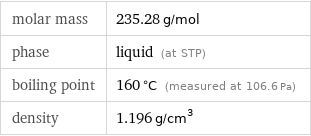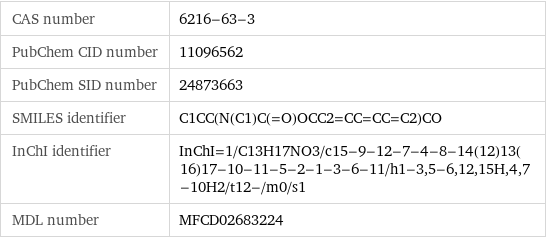Input interpretation

Z-L-prolinol
Chemical names and formulas

formula | C_13H_17NO_3 name | Z-L-prolinol IUPAC name | (2S)-2-(hydroxymethyl)-1-pyrrolidinecarboxylic acid phenylmethyl ester alternate names | (2S)-2-methylolpyrrolidine-1-carboxylic acid benzyl ester | N-Cbz-L-prolinol | phenylmethyl (2S)-2-(hydroxymethyl)pyrrolidine-1-carboxylate mass fractions | C (carbon) 66.4% | H (hydrogen) 7.28% | N (nitrogen) 5.95% | O (oxygen) 20.4%
Lewis structure

Draw the Lewis structure of Z-L-prolinol. Start by drawing the overall structure of the molecule, ignoring potential double and triple bonds: Count the total valence electrons of the carbon (n_C, val = 4), hydrogen (n_H, val = 1), nitrogen (n_N, val = 5), and oxygen (n_O, val = 6) atoms: 13 n_C, val + 17 n_H, val + n_N, val + 3 n_O, val = 92 Calculate the number of electrons needed to completely fill the valence shells for carbon (n_C, full = 8), hydrogen (n_H, full = 2), nitrogen (n_N, full = 8), and oxygen (n_O, full = 8): 13 n_C, full + 17 n_H, full + n_N, full + 3 n_O, full = 170 Subtracting these two numbers shows that 170 - 92 = 78 bonding electrons are needed. Each bond has two electrons, so in addition to the 35 bonds already present in the diagram add 4 bonds. To minimize formal charge oxygen wants 2 bonds and carbon wants 4 bonds. Identify the atoms that want additional bonds and the number of electrons remaining on each atom: Fill in the 4 bonds by pairing electrons between adjacent highlighted atoms. Note that the six atom ring is aromatic, so that the single and double bonds may be rearranged: Answer: | |
3D structure

3D structure
Basic properties

molar mass | 235.28 g/mol phase | liquid (at STP) boiling point | 160 °C (measured at 106.6 Pa) density | 1.196 g/cm^3
Units

Liquid properties (at STP)

density | 1.196 g/cm^3 refractive index | 1.54
Units

Chemical identifiers

CAS number | 6216-63-3 PubChem CID number | 11096562 PubChem SID number | 24873663 SMILES identifier | C1CC(N(C1)C(=O)OCC2=CC=CC=C2)CO InChI identifier | InChI=1/C13H17NO3/c15-9-12-7-4-8-14(12)13(16)17-10-11-5-2-1-3-6-11/h1-3, 5-6, 12, 15H, 4, 7-10H2/t12-/m0/s1 MDL number | MFCD02683224
Safety properties

flash point | 110 °C